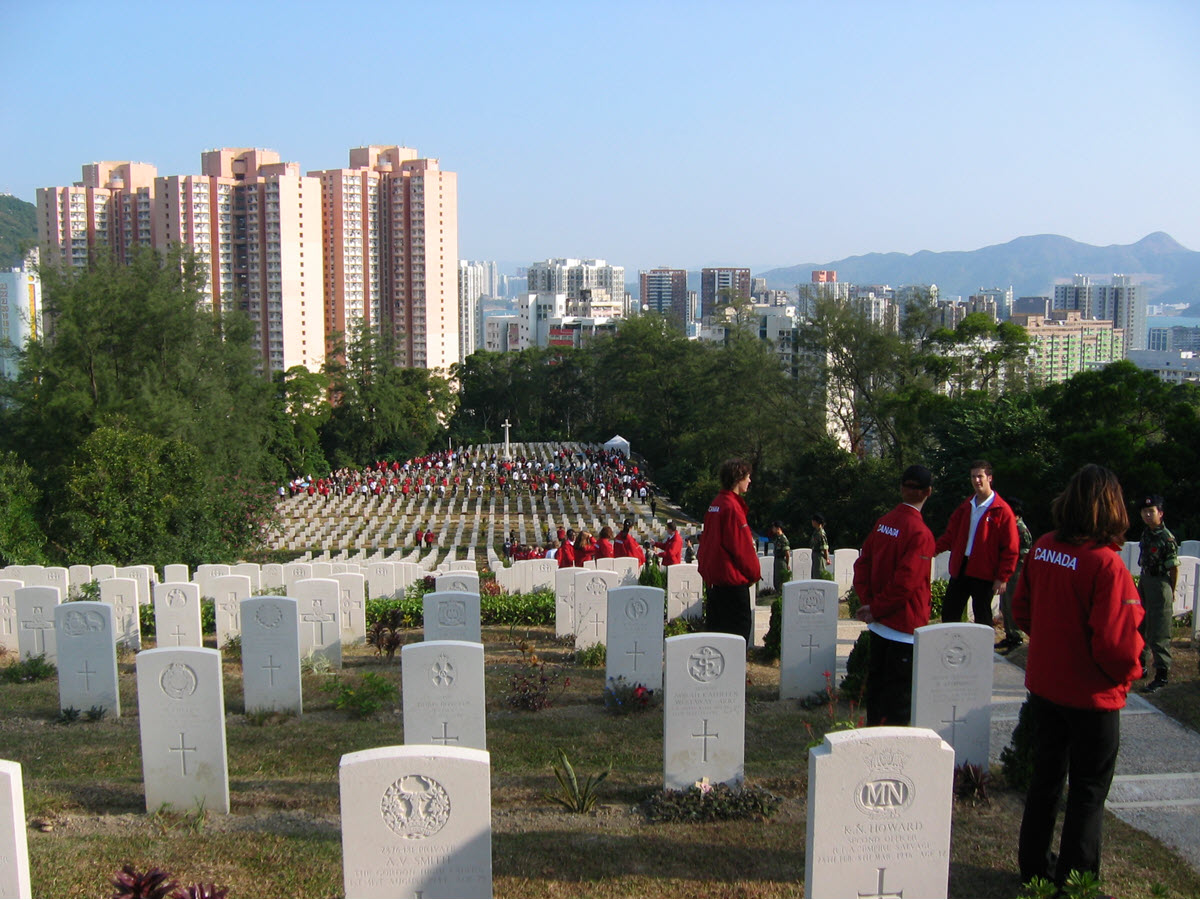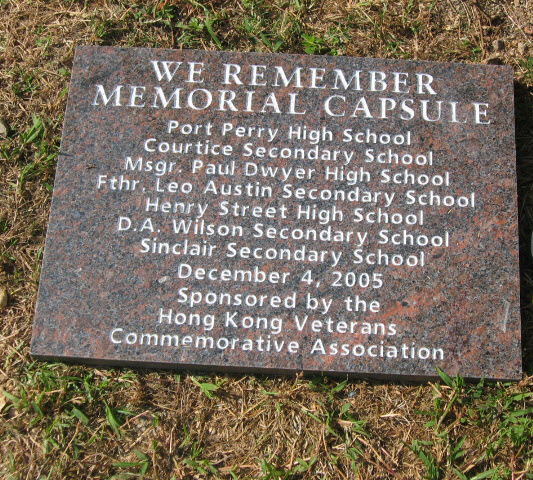Daughter Pat's Visit to Hong Kong
And finally, Pat writes a letter while flying home from her first pilgrimage to Hong Kong in December of 2005:
As many of you know, my father was a POW in Hong Kong for the duration of World War II, having been captured by the Japanese on Christmas Day, 1941. He and the other POWs were the last soldiers to come home after the war was over. My daughter, Carole, Shelagh’s son, Mark, and I have been part of a group involving members of the Hong Kong Veterans’ Commemorative Association (HKVCA) from across Canada who travelled to Hong Kong in the first week of December to commemorate the battle of Hong Kong, which began nearly 65 years ago on December 8th, 1941, as part of the same raid as the attack on Pearl Harbour.
Our journey began on December 1st, with a surprising route across Hudson’s Bay to the Arctic Ocean and down across China until we reached Hong Kong on the other side. We landed at the new airport, since Kai Tak airport, which our POWs helped construct during their slave labour in the war years, is no longer used. The hotel we stayed at was in North Point, and, amazingly enough, North Point district was the location of the prison camp in which our soldiers lived for the first few months of their captivity. They were eventually moved to Shamshuipo, their original barracks in Kowloon on the mainland, an area which is now a small park with the appropriate plaques noting the site as a prison camp in World War II.
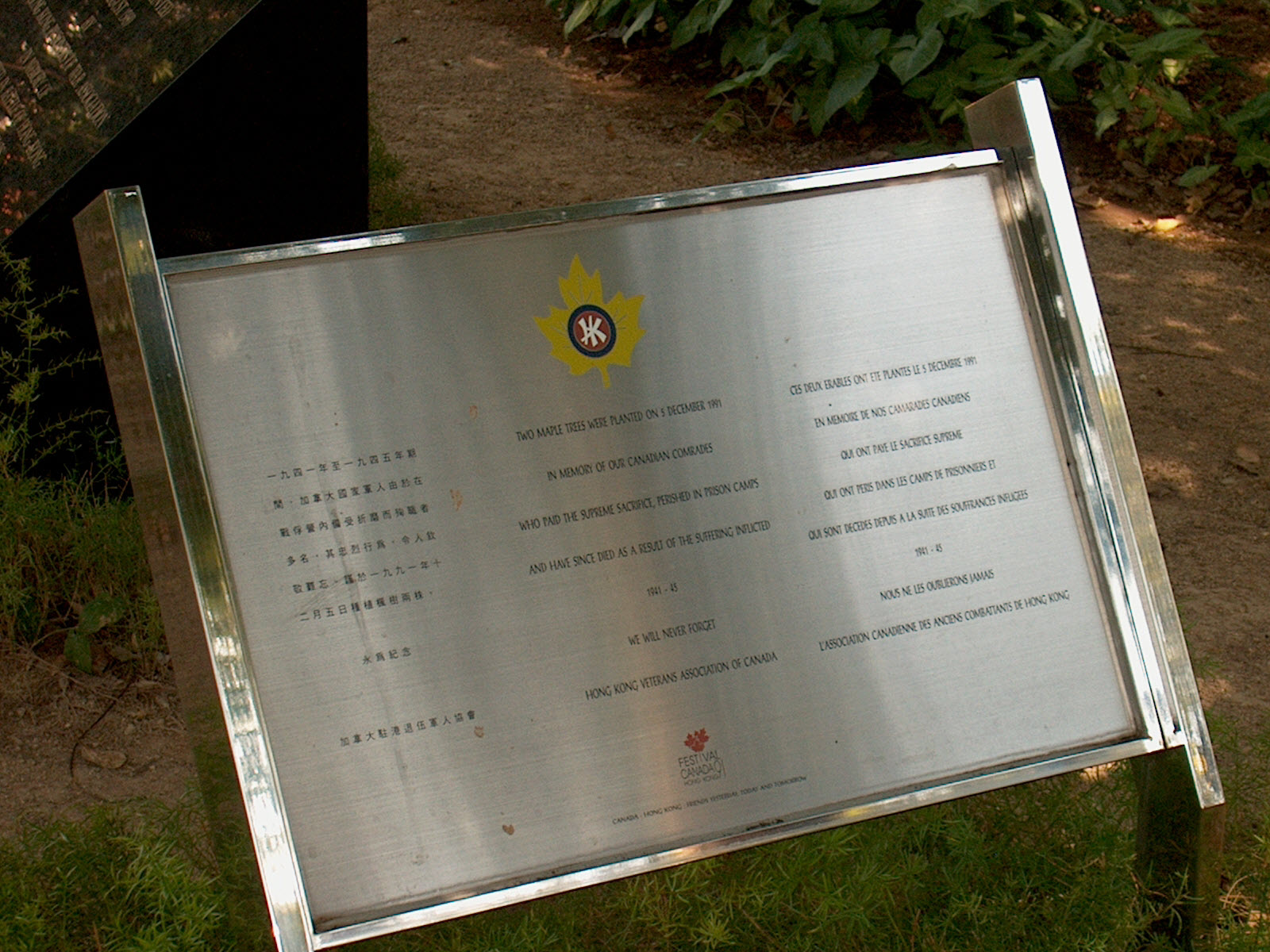
One of the two plaques at Sham Shui Po in memory of all who died in the Battle (JRT Photo). Click for larger view.
Veterans Affairs helped finance this pilgrimage, although the idea originated with Mike Babin, a member of the Executive in Ontario. It is due to Mike’s diligence that the trip became a reality. The objective was to learn as much as we could, to see as many of the battle sites as possible, and to be a part of the special ceremonies which would commemorate the Battle of Hong Kong and honour the war dead.
One of the highlights of our stay was the ceremony at Sai Wan cemetery on Sunday, December 4th, our third day there. Our 38-member delegation from HKVCA was impressed by a number of things. The site itself is rather spectacular, sweeping down from a hillside location, through the several hundred grave sites to the cenotaph located at the base of a series of stairs. As the guests descended the hill, on each side of these stairs were stationed Canadian students from seven Ontario High Schools acting as an honour guard along with the Hong Kong army cadets in their fatigues on the other side. The students, part of a 210-person delegation from Ontario, had just completed a four-city tour of China and were making this their very special final stop in order to bury a memorial capsule near the Canadian soldiers whose lives they had been studying in school this past year.
Near the cenotaph a 120-voice choir from the Canadian International School of Hong Kong was standing by, ready to perform during the ceremony. In addition, Chinese Scouts, and more students from Ontario’s Durham Region High Schools, were at each Canadian gravesite ready to place on each grave the flowers and the poppy-decorated crosses they had with them. During the ceremony, many wreaths were laid, and the veterans themselves, including “Flash” Clayton and George MacDonell from the Royal Rifles of Canada spoke on behalf of the veterans, as did Phil Doddridge, the National President of the Hong Kong Veterans’ Association. Canadian Senators Vivienne Poy and Larry Campbell also spoke, as did many other dignitaries. A most special time for us all!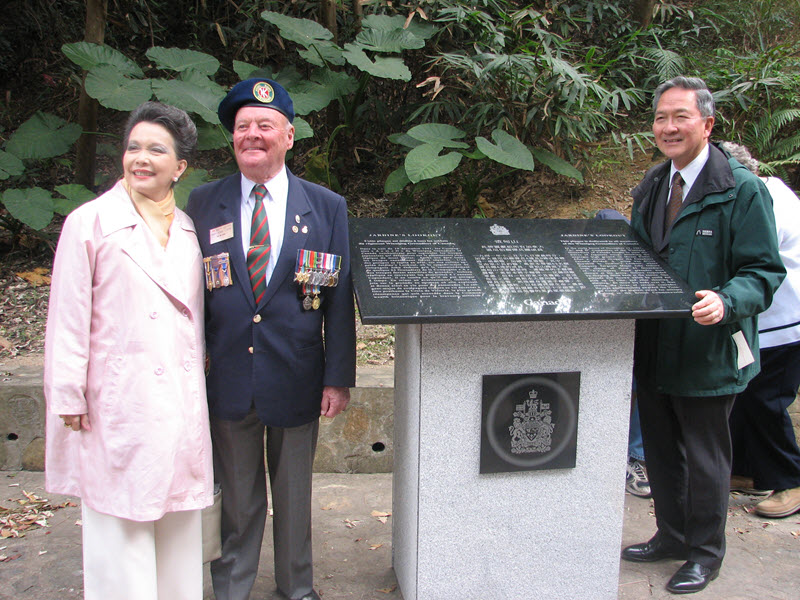
Uveiling the plaque at Jardine's Lookout. LtoR: Senator Poy, Hong Kong Veteran Bob "Flash" Clayton, Unanmed local representative. (VAC Photo) Click for larger view.
It became obvious early on that the people of Hong Kong are very much aware of the part played by the Canadian soldiers in the Battle for Hong Kong. The government has been developing a hiking/walking trail along the various battle sites, and there are now a number of stations where boards and plaques have been erected to note which of the two Canadian battalions, the Royal Rifles or the Winnipeg Grenadiers, was involved at a particular location. We were privileged to be in the company of the six Canadian veterans for much of our stay, and learned many things from them about the specifics of their personal situation. There were three locations where the plaques had recently been installed. At each site, one of the veterans was chosen to unveil the plaque and speak to the dedication of that particular plaque. These were most touching moments because the veteran involved was chosen as one who had fought in that specific location.
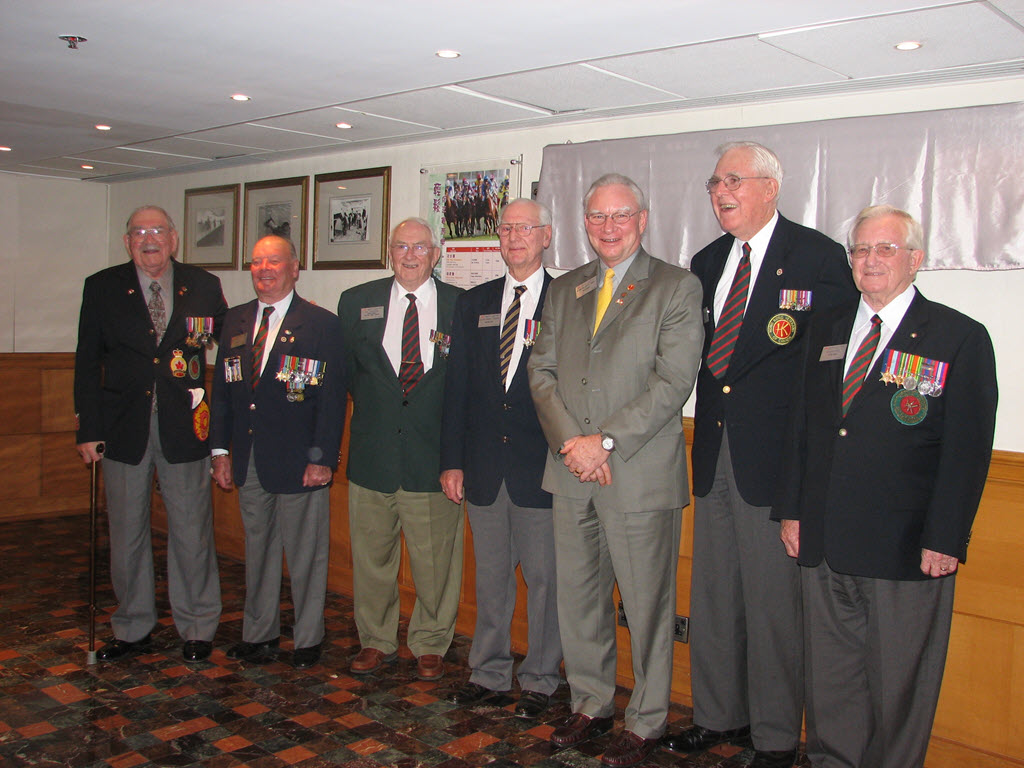
Left to right: Mr. Ed Shayler, Mr. Flash Clayton, Mr. Phil Doddridge, Mr. Gerry Gerrard, Senator Larry Campbell, Mr. George MacDonell and Mr. Doug Rees. (VAC Photo). Click for larger view.
The evenings were spent at special events honouring the veterans, and included a reception and dinner at the Hong Kong Jockey Club. This occasion, with wonderful food and speeches reflecting the importance of the occasion, overlooked the Happy Valley racetrack ten stories below, the place where the Japanese advance was halted when the surrender came those 65 years ago. One thing became very clear as we heard speakers at the various events extolling the efforts of the Royal Rifles of Canada and the Winnipeg Grenadiers in that difficult conflict. The two battalions were determined to fight bravely to the end. In one situation, with some of the thousands of Japanese soldiers approaching, one group managed to hold off the advance for three days near the top of a mountain. The Japanese built a statue during the occupation to their soldiers lost in that encounter, claiming afterwards that the defenders must have totaled at least 400 men, as they sustained many casualties. In reality, there were 89 defenders.
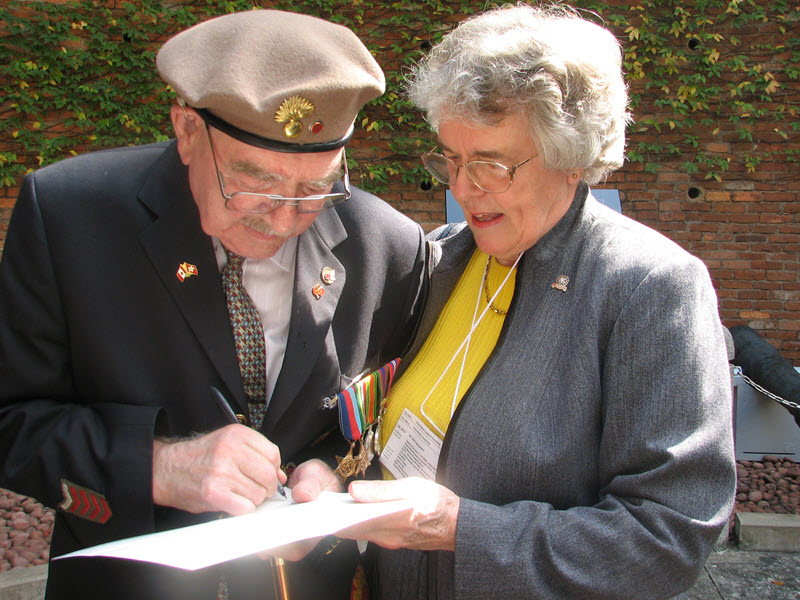
Pat Turcotte and Hong Kong Veteran, Ed Shayler, who had been Lt. Corrigan's Sergeant during the Battle of Hong Kong (VAC Photo). Click for larger view.
A second very special evening was the Farewell dinner for the veterans themselves. The veterans and the Veterans Affairs team had arrived two days before us and were about to leave two days before we did. It was a splendid affair at the Repulse Bay Hotel, a wonderful spot facing the South China Sea. We had a reception on the front lawn early in the evening, with waiters proferring drinks as we chatted with veterans, Veterans Affairs personnel, and dignitaries from Hong Kong itself, surrounded by cloth-covered chairs and tables in white, and goodies to munch as we awaited the call to dinner. Once inside the Verandah area, which was a dining hall the full width of the hotel, we were seated at probably 25 tables of ten along the hall, with large TV screens mounted on the walls at both ends featuring the pictures that had been taken that day and during the earlier part of the tour. A most special time, for me in particular, as I had been seated next to Ed Shayler, the Hong Kong veteran who was my father’s sergeant, and was with him through all of the fighting. He had much to tell me about the battle, and his relationship with my father. What an evening!
The next day was our turn to tour the battle sites. Our guide was an expert on the battle itself, a Hong Kong resident named Tony Banham. Tony was able to answer all of our questions about where our fathers might have fought, and to make very clear just what they were up against in facing an invasion force of up to 60,000 men, their own forces being no more than 14,000 soldiers and civilians. The energy expended retracing their steps on this very hilly island, without packs, heavy guns and ammunition, made us appreciate in a very small sense, just how difficult the defence of Hong Kong must have been. In one section, we had to descend over 300 steps to get to the next area of interest, and without a doubt, even going down rather than up, it was difficult enough to do. Daughter Carole and I decided to retrace the trek the next day, our one free day before going home, so that we could take more pictures, and found those same 300 steps really exhausting, as we climbed up the steep slopes one more time.
All of those who made the trip have come away with memories which will never be forgotten. The most special of these has to be seeing the veterans so honoured, and to know that they are now aware that a growing number of people inside Canada, and outside the country as well, do appreciate what they achieved in those difficult years. Among their most joyous moments was the lowering of the memorial capsule into the ground just outside the gates of Sai Wan Cemetery containing the stories, poems, letters, and CDs which were the Canadian students’ creative responses to getting to know the Hong Kong Veterans they researched at school before they arrived in Hong Kong. The six honoured at Sai Wan Cemetery, and Stanley Cemetery, will never be forgotten by Canadians. The trip of a lifetime for all of us!
Cheers!
Pat
P.S.
There is much more information about HKVCA and our various pilgrimages to Hong Kong on our Website: www. hkvca.caLieut. Leonard B. Corrigan's handwritten diary, along with a number of artifacts, is housed in the Manitoba Museum in Winnipeg, MB., along with other memorabilia of the Winnipeg Grenadiers.
